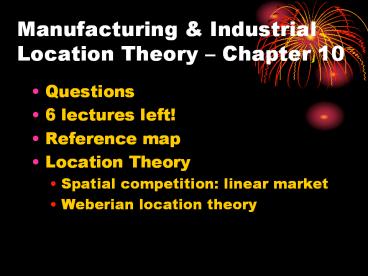Manufacturing PowerPoint PPT Presentation
1 / 19
Title: Manufacturing
1
Manufacturing Industrial Location Theory
Chapter 10
- Questions
- 6 lectures left!
- Reference map
- Location Theory
- Spatial competition linear market
- Weberian location theory
2
Linear Market Competition
- The importance of location in spatial
competition - Linear market
- H. Hotellings Model (The Ice Cream Vendor on
the beach) - Picture a crowded beach.
3
Where should ice cream vendors locate?
- And the beach with an economic geographer...
Ivan lifts a lot of weights
4
Hotellings Ice Cream Vendor Problem
Lets make some assumptions before we start
looking for ice cream vendors or anything else
5
Spatial competition in a linear market
A
B
C
D
E
- Uniform distribution of ice cream consumers on
beach - Demand for ice cream is inelastic (every
consumer wants a cone no matter what the real
price.) - Market price is 1, tptn costs are 0.10 per
metre - Consumers will always buy at the closest market
source - Vendor is mobile but constrained to 5 locations
- No commercial inertia
6
Spatial competition in a linear market
Time t1 Bob enters first.
A
B
C
D
E
Units of demand / distance
10
10
10
10
Bob captures entire market
7
Spatial competition in a linear market
Time t2 Peter enters market.
A
B
C
D
E
Units of demand / distance
10
10
10
10
Bob already in market at position A. Where should
Peter locate?
8
Spatial competition in a linear market
Time t2 Peter enters market.
A
B
C
D
E
Units of demand / distance
10
10
10
10
Bob already in market at position A.
Where should Peter locate?
9
Spatial competition in a linear market
Time t3 Bob Retaliates and Moves
A
B
C
D
E
Units of demand / distance
10
10
10
10
Bob already in market at position A.
Peter in market at B
Bob relocates to C
10
Spatial competition in a linear market
Time t4 Peter Retaliates and Moves to C
A
B
C
D
E
Units of demand / distance
10
10
10
10
Peter in market at B
Bob in market at C
Peter retaliates and moves to C
11
Spatial competition in a linear market
A
B
C
D
E
Peter
Bob
- From free market to regulated markets
- State establishes market locations
- Peter and Bob apply for and receive a centrally
planned market stall, exclusive access for the
season for a fee
12
Spatial competition in a linear market
A
B
C
D
E
Peter
Bob
- Aggregate travel for consumers is reduced,
improving welfare
13
Alfred Weber, 1909
- Theory of the Location of Industries
- Assumptions
- Isotropic surface
- Single product plant
- Localized raw materials
- Single point market
- Labour is available
- Tpt costs a function of weight and distance
- Focus on transportation costs
14
Alfred Weber, 1909One market, one localized RM
source
- Ubiquitous raw material? market orientation
- Pure RM ?anywhere from RM location to market
location - Are we sceptical?
- Assuming no terminal costs!
- Assuming FR on RM FR on FP
- Gross RM ?RM orientation
15
Alfred Weber, 1909 Material index
- Material/market orientation
- gt1
- lt1
- 1?
16
Alfred Weber, 1909One market, two localized RMs
- Lets assume two localized RM sources,
- S1 S2
- Pure RMs, equal parts of FP weight
17
Alfred Weber, 1909One market, two localized
Gross RMs
- Lets assume two localized Gross RM sources, S1
S2 - Gross RMs, 50 weight loss for each
- S1, S2, or M
- 4
18
Transport cost matrix industriallocation at
point M
Destination Origin S1 S2 M
S1 2
S2 2
M
Total Tptn Cost 4
19
Transport cost matrix industriallocation at
point S1
Destination Origin S1 S2 M
S1 0 1124
S2 2
M
Total Tptn Cost 4

